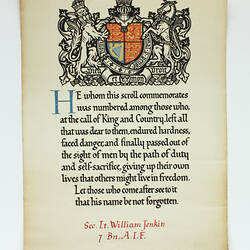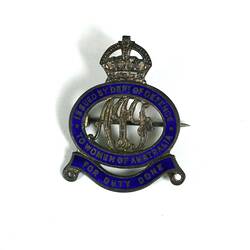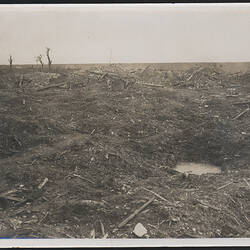Summary
Alternative Name(s): Mothers & Widows Ribbon
Black badge embroidered with Australian Military Forces crest and wattle emblem words 'For Australia' below. White metal bars at top and bottom one brass star on bottom bar indicating one son or husband killed. Number on rear of top clasp: 35536. The badge came with a small collection of material relating to the service and death of 2nd Lieutenant William Jenkin, 7th Battalion, AIF, who was killed in action in France on 19 August 1916. The badge was probably presented to his widow, Mrs E. A. B. Jenkin.
William was born in Richmond and educated at Wesley College, where he had been a Senior Cadet. He obtained a diploma in geology at the University of Melbourne, and then found a position as an articled surveyor for the Department of Lands & Survey. He married young, to Enid, and they lived at 'Gracedale', in Elizabeth Street, Malvern. William enlised in June 1915, at the age of 22. He was placed in the 7th Battalion. He attended Officers' Training School at the AIF camp in Broadmeadows, Melbourne, and in March successfully applied for a commission, becoming a lieutenant. On 1 April he was sent overseas on the 'Suffolk', disembarking at Suez on 12 May. Just over a week later he was shipped to Marseille, France, and by early July he was at the front lines, serving with the 1st Entrenching Battalion. He survived only a matter of weeks before being fatally wounded at Purbricks Sap on the Bapaume Road. Corporal Dudley reported that he saw William 'blown up by his own bomb'.
William was buried where he fell, but the location of his body was later lost. A court of enquiry, held in June 1917, confirmed his death (he had initially been reported missing). He is commemorated at the Villers-Bretonneux Memorial, Picardie, France. After his death Enid moved to Sandringham and re-married, becoming Mrs Lording. Her husband was Ernest Lording, who she sent to collect William's memorial plaque on her behalf in 1923. They lived in Pascoe Vale.
According to the Australian War Memorial, the badge was officially sanctioned in Military Order 64 of 1919. The Barrier Miner (NSW) announced on 4 June 1919 that badges were now being issued to the mothers and widows of those 'who have been killed in action or died of wounds or other causes while serving, or who after discharge died from causes directly attributable to wounds or sickness incurred while on service'. Appropriate wear was prescribed: 'When the badge is worn it should be attached to the dress, on the right breast'. A total of 30,000 badges were ordered (although over 60,000 were killed). Delivery was delayed due to power restrictions during 'the strike' (thousands of seamen were involved in industrial action during 1919), and the contractor struggling to produce the necessary quality for the metal bars.
Physical Description
Black ribbon, machine-embroidered with rising sun and wattle emblems. Ribbon suspended from a white metal bar which bearing laurel leaves. A bottom bar has a single star (indicative of the number of relatives killed).
More Information
-
Collection Names
Returned and Services League (RSL) Collection, Military Memorabilia Collection
-
Collecting Areas
-
Acquisition Information
Donation from Mrs W. Lording, 15 Jul 1986
-
Person Commemorated
2nd Lieutenant William Jenkin - Australian Imperial Force (AIF), 1919 or later
-
Date Made
-
Inscriptions
On fabric: 'AUSTRALIAN MILITARY / FORCES / FOR / AUSTRALIA'. On rear top of clasp: '35536'.
-
Classification
-
Category
-
Discipline
-
Type of item
-
Overall Dimensions
5.7 cm (Width), 10.4 cm (Height)
-
References
Australian War Memorial Encyclopaedia, 'The Mothers and Widows Badge', [Link 1] accessed 27 Mar 2013. MOTHERS AND WIDOWS' BADGES. (1919, June 4). Barrier Miner (Broken Hill, NSW : 1888 - 1954), p. 1. Retrieved March 27, 2013, from [Link 2] WAR BADGES FOR WOMEN. (1919, September 19). The Argus (Melbourne, Vic. : 1848 - 1956), p. 6. Retrieved March 27, 2013, from [Link 3] National Archives of Australia, JENKIN William, series B2455, barcode 7336532.
-
Keywords
Wars & Conflicts, World War I, 1914-1918, Death & Mourning, Battle of the Somme (Somme Offensive), 1916





